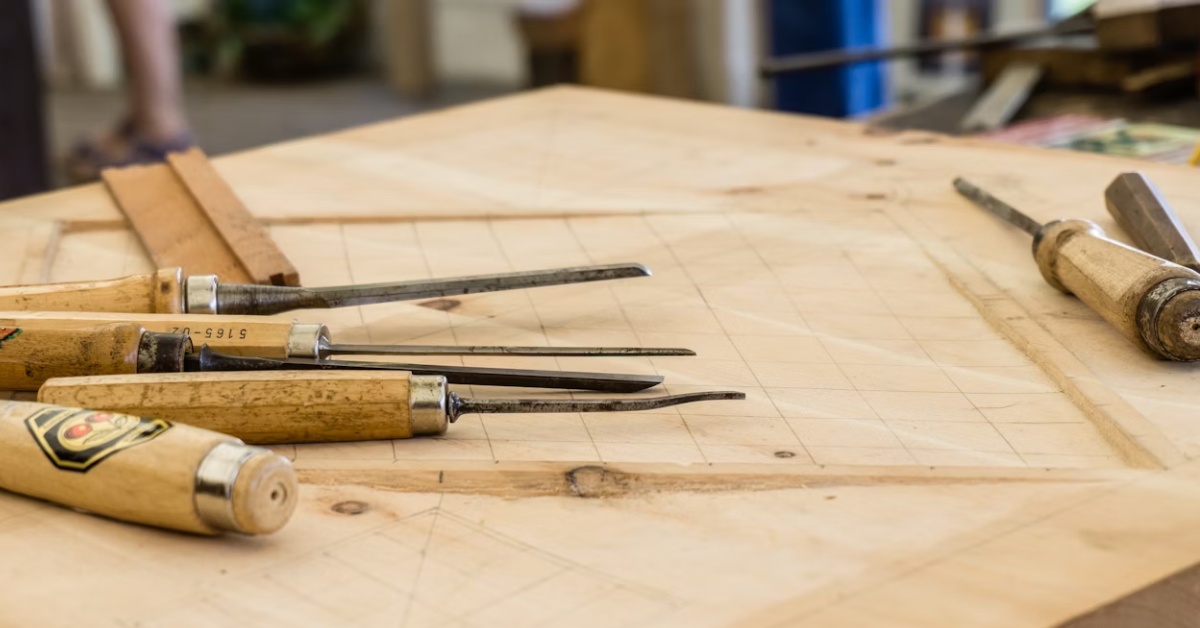
Amish furniture, renowned for its craftsmanship and durability, owes much of its charm and resilience to the choice of wood. Each type of wood, with its unique properties and beauty, plays a pivotal role in creating pieces that are not only functional but also rich in heritage and style.
The craftsmanship and durability of Amish furniture are heavily influenced by the use of specific woods like Oak, Cherry, Maple, Walnut, and Hickory, each imparting unique characteristics and care needs that define the furniture’s quality and style.
Let’s explore the pivotal role of wood selection in shaping Amish furniture’s functionality, style, and enduring legacy. Let’s uncover the unique characteristics, harvesting methods, and care practices of each wood type used in these timeless creations.
Types of Wood Used in Amish Furniture
In Amish furniture making, selecting wood is crucial, emphasizing high-quality materials to ensure style and functionality. The variety of woods the Amish use showcases their adaptability and commitment to quality.
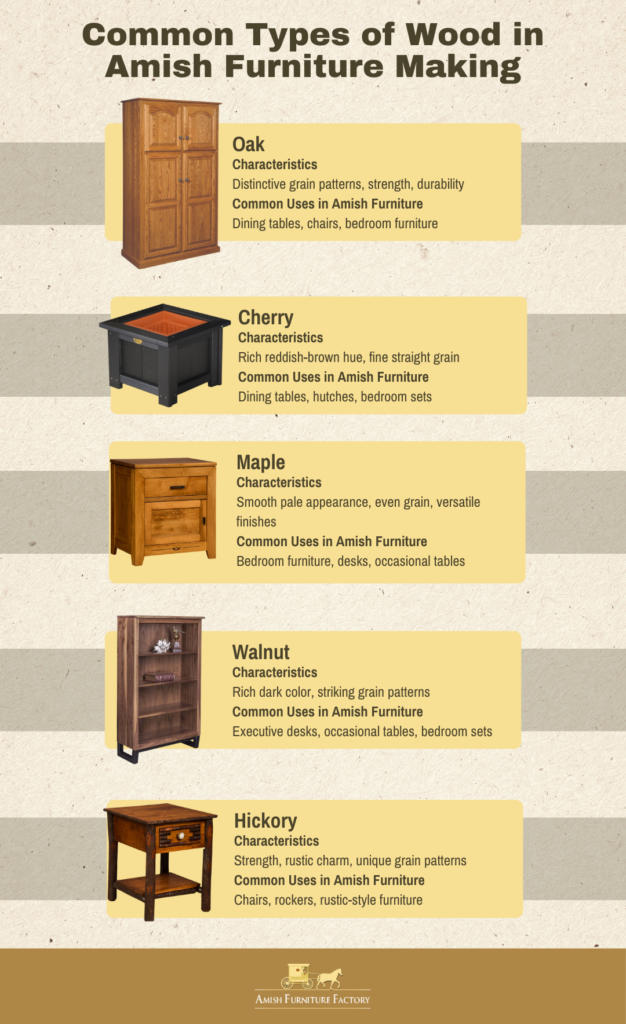
Oak Wood
Oak wood is a staple in Amish furniture production. Its distinctive grain patterns, strength, and durability make it an excellent choice for crafting sturdy and long-lasting furniture pieces. Amish artisans appreciate oak’s versatility, as it can be stained to achieve various finishes, from light to dark. Oak’s prominent presence in Amish furniture is evident in classic pieces such as oak dining tables, chairs, and bedroom furniture sets.
Cherry Wood
Cherry wood is prized for its rich, reddish-brown hue that deepens over time, giving Amish furniture a warm and inviting appearance. This wood type boasts a fine, straight grain that contributes to its elegant and timeless look. Cherry wood is highly regarded for its ability to age gracefully, developing a beautiful patina with time. Amish craftsmen often use cherry wood for crafting dining room tables, hutches, and bedroom sets that exude sophistication.
Maple Wood
Maple wood is favored for its smooth, pale appearance and fine, even grain. It is known for its ability to take on various finishes, including natural, honey, or dark stains, allowing Amish furniture makers to achieve a wide range of styles. Maple wood’s durability and resistance to wear make it suitable for crafting bedroom furniture, desks, and occasional tables, which can withstand the test of time.
Walnut Wood
Walnut wood is prized for its rich, dark color and striking grain patterns. Amish furniture made from walnut showcases a luxurious and opulent feel. The wood’s natural beauty and elegance make it a popular choice for crafting executive desks, occasional tables, and handcrafted bedroom sets that become heirloom pieces in many households.
Hickory Wood
Hickory wood is celebrated for its strength and rustic charm. Its unique grain patterns and natural variations in color create a distinctive appearance that appeals to those seeking a more rugged or rustic aesthetic. Amish artisans often use hickory for crafting chairs, rockers, and rustic-style furniture that adds character to any room.
Janka Hardness Scale Ratings
Different woods used in Amish furniture have varied Janka hardness ratings. These ratings reflect the wood’s ability to resist wear and denting and indicate how well it can handle the rigors of daily use and the demands of different furniture types.
From the WoodWorkers Guild of America, George Vondriska provides insight into the Janka hardness scale:
“The Janka hardness scale is based on a test that measures the amount of force needed to make a specific-sized impression in wood. The test has been performed on thousands of wood species, and serves as a great reference for woodworkers… The Janka hardness scale gives you an objective frame of reference to compare a new species to ones that you are familiar with as a way to screen the new species for a project.”
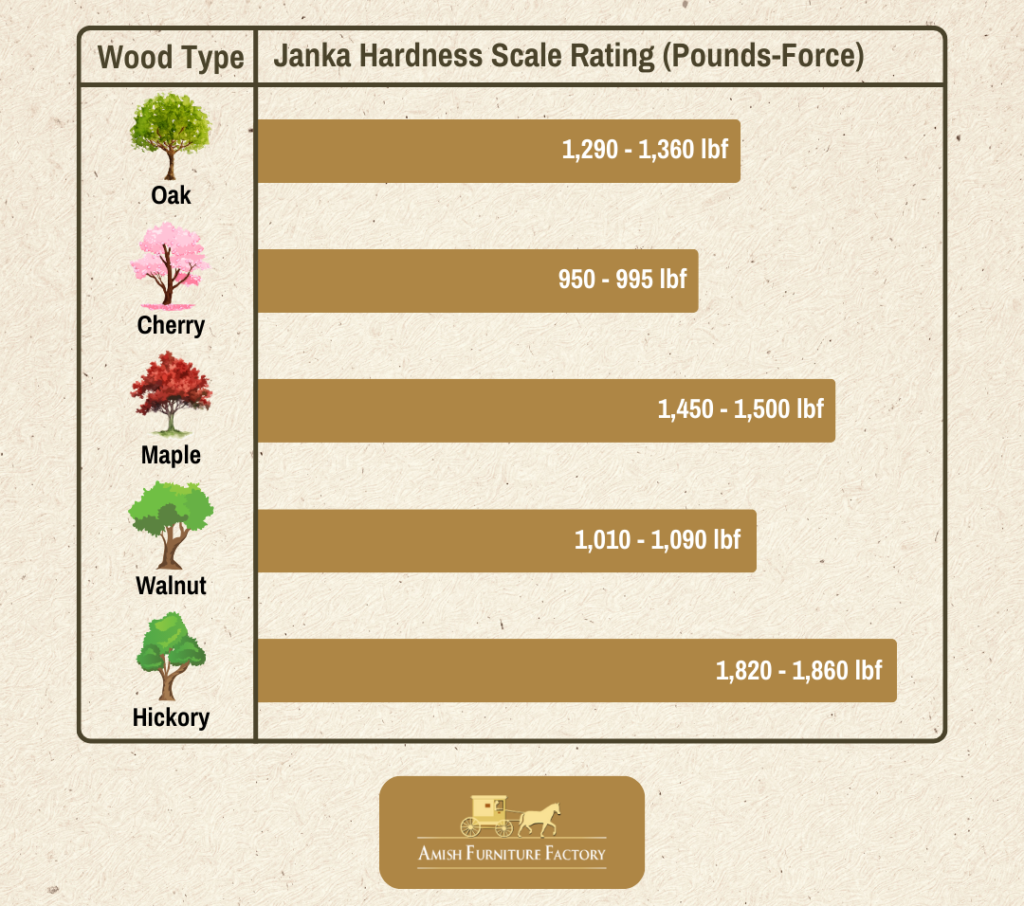
Harvesting Processes of Woods for Amish Furniture
The harvesting processes of woods used in Amish furniture are integral to their quality and sustainability. Each wood type has its specific harvesting technique, ensuring the longevity and durability of the final furniture piece.
Red Oak and White Oak are predominantly harvested in the forests of North America, following sustainable forestry practices.
This process involves methods that consider the specific light requirements of these trees. Oaks need considerable light to grow, which is not feasible in densely wooded areas.
Techniques like small-scale clearcuts, seed-tree harvests, and shelterwood harvests are employed. These methods create enough light for oak regeneration and involve the selective removal of trees to ensure new oak seedlings and saplings receive the necessary sunlight.
Maple Wood
Maple wood is usually a sustainable choice for many due to its carbon-sequestration ability and the abundance of maple trees. These trees capture carbon, aiding in climate crisis mitigation, and the wood serves as long-term carbon storage.
Maple wood is harvested using sustainable methods, such as clear-cutting, particularly in Northern Maine. This method removes all trees and is especially effective for species like Maple that require full sunlight to thrive.
Clear-cutting supports the growth of these sunlight-loving species by providing abundant light and warmer ground but also serves as an ecological and economic strategy to reduce the impact of natural forest clearings caused by fires, insects, or floods.
This method aligns with sustainable forestry practices, ensuring Maple forests’ long-term viability and health.
Hickory Wood
Harvesting Hickory wood involves sustainable practices suited to its characteristics as a deciduous tree. Typically harvested in late fall or winter when sap levels are lower, this timing ensures easier milling and minimizes damage.
The shelterwood method, involving the phased removal of mature Hickory trees over 10 to 15 years, is frequently used. This approach aids the regeneration of Hickory under partial canopy cover, which is crucial for growing young trees.
While offering wildlife benefits, this method necessitates careful planning to reduce soil disturbance and protect against wind damage to remaining trees.
Price Comparison of Different Woods
Various factors such as availability, harvesting methods, and wood characteristics influence the cost of wood used in Amish furniture. Understanding these price dynamics is crucial for consumers and Amish furniture industry makers.
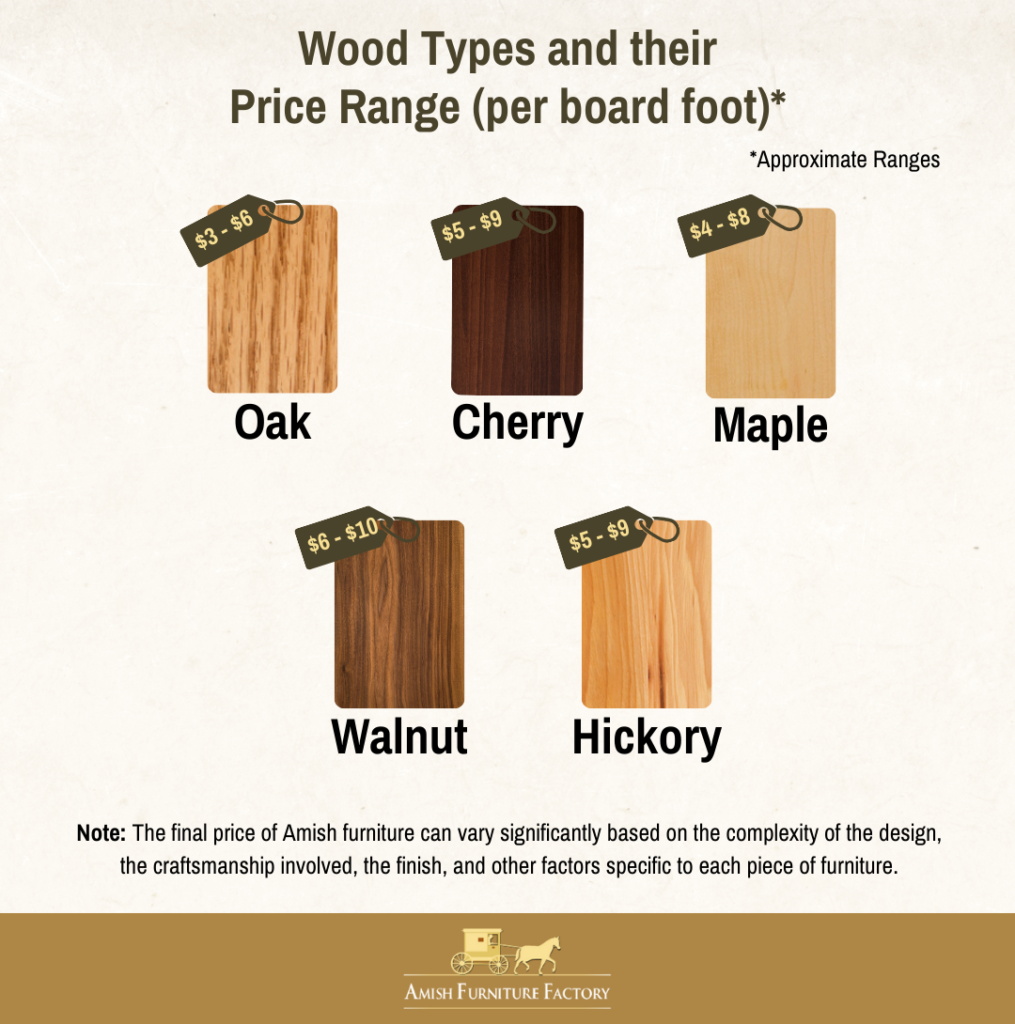
Note: The final price of Amish furniture can vary significantly based on the complexity of the design, the craftsmanship involved, the finish, and other factors specific to each piece of furniture.
Care and Maintenance
Proper care and maintenance practices are essential for preserving the beauty and extending the life of Amish furniture made from different types of wood.
Red Oak and White Oak
Regular dusting with a soft, dry cloth is essential for Red and White Oak furniture. Occasional polishing with a specific wood cleaner can restore its luster. To maintain the wood’s integrity and appearance, it’s important to avoid exposing it to excessive moisture and direct sunlight, as these factors can lead to discoloration and warping over time.
Cherry Wood
Cherry wood furniture should be dusted regularly with a soft, lint-free cloth. While cherry wood naturally darkens and develops a patina over time, if you want to preserve its original color, it’s best to minimize its exposure to direct sunlight. Using furniture wax or polish specifically designed for cherry wood can help maintain its sheen and protect it from minor scratches.
Maple Wood
To care for furniture made from maple wood, use a soft cloth for regular cleaning and a non-abrasive cleaner when needed. It’s important to avoid exposing maple wood to extreme temperature changes, as this can cause it to warp or crack. Additionally, protecting it from sharp objects and using coasters for beverages can prevent scratches and stains on the surface.
Walnut Wood
Walnut wood furniture should be dusted regularly with a soft cloth to prevent the buildup of dirt and dust. Like cherry wood, walnut wood will naturally darken over time, creating a rich patina. If you wish to maintain its original color, limit its exposure to direct sunlight. Applying a wood conditioner or wax designed for walnut can help preserve its natural beauty and protect it from minor scratches.
Hickory Wood
Hickory’s durability makes it relatively low-maintenance. Regular dusting with a soft cloth is recommended to keep it clean and free from dust particles. In case of spills, immediate cleaning is advisable to prevent stains. Using coasters and pads under objects like cups and utensils can also help prevent scratches on the surface. Hickory’s rugged appearance tends to embrace wear and tear, but these simple precautions can keep it looking its best for years to come.
Specialty Woods Used In Amish Furniture Making
In the world of Amish furniture craftsmanship, where quality and attention to detail are paramount, the choice of wood is more than just a practical decision; it’s an art form in itself.
While common wood types like oak, cherry, maple, walnut, and hickory are the foundation of Amish furniture, specialty woods bring a unique touch to the craft, offering a spectrum of aesthetics and characteristics that cater to specific design preferences and individual tastes. These specialty woods allow Amish artisans to create exceptional and one-of-a-kind furniture pieces that resonate with discerning customers.
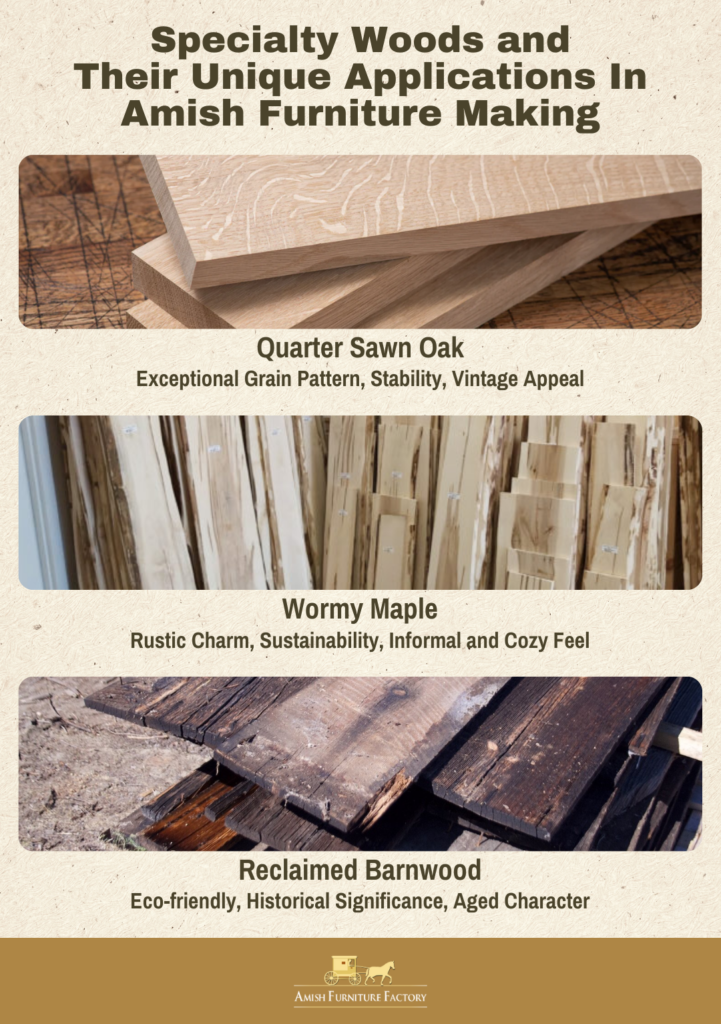
Quarter Sawn Oak
Quarter sawn oak, sometimes referred to as “tiger oak,” stands out for its exceptional grain pattern. Unlike plain sawn wood, quarter sawn oak is cut in a way that exposes stunning ray or fleck patterns, creating a visual masterpiece. This unique grain pattern features straight lines and consistent grain patterns, making it highly sought after, particularly in traditional and mission-style Amish furniture.
Exceptional Grain Pattern: The ray or fleck pattern adds depth and visual interest to furniture, making each piece a work of art.
Stability: Quarter sawn oak is known for its stability, making it less prone to warping and splitting, ensuring that your furniture will stand the test of time.
Vintage Appeal: It perfectly complements styles with a historical or classic aesthetic, evoking a sense of timeless beauty.
Wormy Maple
Wormy maple, also affectionately known as ambrosia maple, boasts unique dark streaks and small holes, a result of the presence of ambrosia beetles during the wood’s growth. These natural markings create a rustic and distinctive appearance that appeals to those seeking a more informal or rustic style in their Amish furniture.
Rustic Charm: The wormholes and streaks add character and uniqueness to each piece, making it impossible to replicate.
Sustainability: Utilizing wood with natural imperfections contributes to environmental sustainability by reducing waste in the lumber industry.
Informal and Cozy Feel: Wormy maple is the perfect choice for crafting casual and welcoming furniture that creates a cozy ambiance.
Reclaimed Barnwood
Reclaimed barnwood tells a unique story through its aged appearance. Sourced from weathered barns and structures, it boasts nail holes, knots, and a captivating patina that speaks of its previous life. Each piece of reclaimed barnwood carries with it a sense of history, making it more than just furniture; it’s a piece of heritage.
Eco-friendly: Repurposing old wood reduces the demand for new timber, contributing to eco-conscious furniture crafting.
Historical Significance: Each piece carries the echoes of bygone eras, adding depth and character to your space.
Aged Character: The weathered look of reclaimed barnwood lends a rustic and charming appeal that is truly unique.
Understanding the Craft: Wood Choices in Amish Furniture
In Amish furniture, choosing wood is more than a mere practical decision; it’s a testament to a rich heritage of craftsmanship. Each type of wood, from the robust Oak to the resilient Hickory, carries its own story, reflected in its unique characteristics and care requirements.
This exploration through different woods and their nuances underscores the deep connection between the material and the artistry of Amish furniture making. As we appreciate the beauty and durability these woods bring into our homes, we also embrace a legacy of skill, sustainability, and timeless design.
